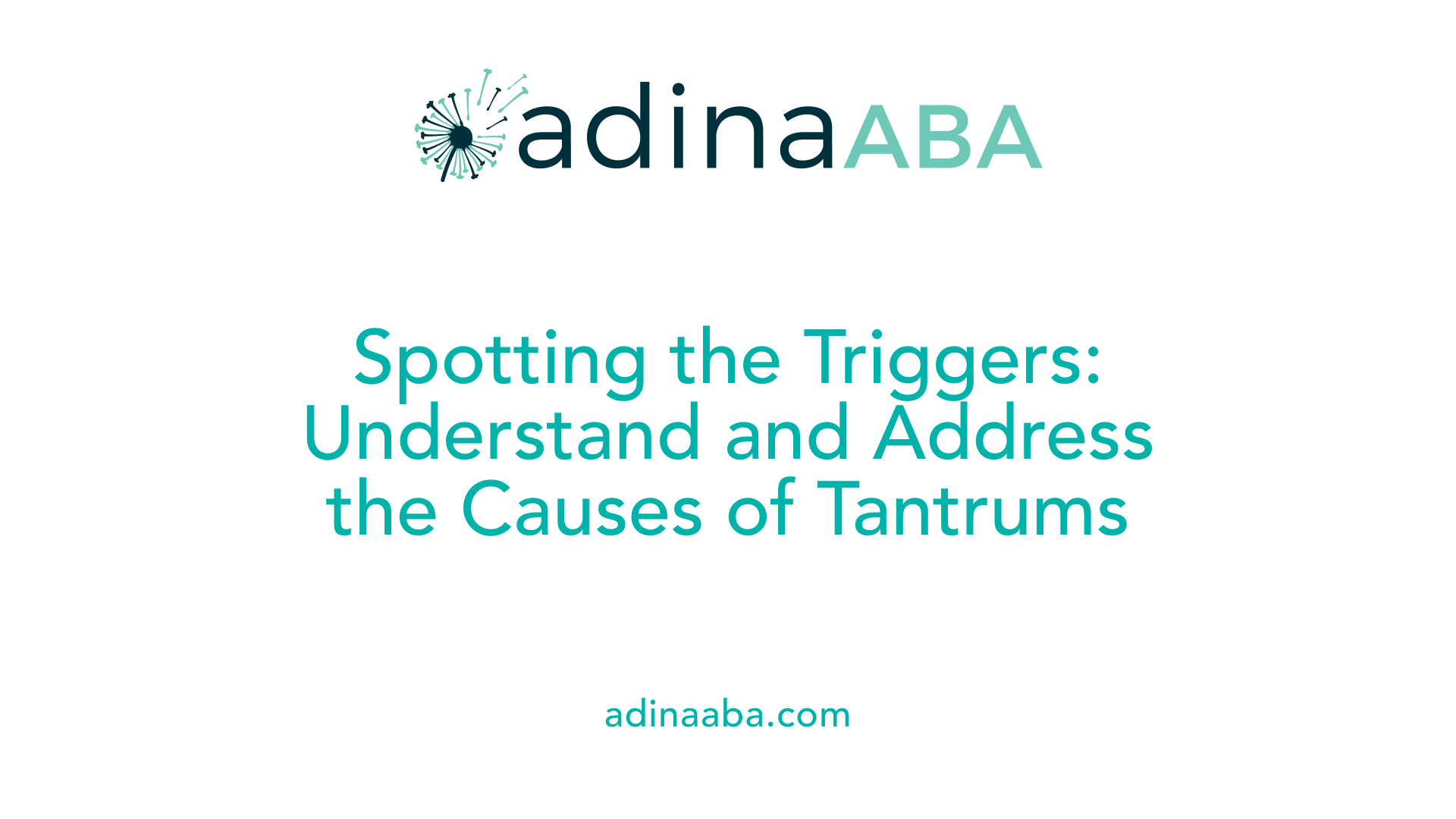ABA techniques to reduce tantrums and outbursts

Understanding and Addressing Tantrums in Children with Autism
Tantrums and outbursts are common challenges faced by children with autism. These behaviors often stem from unmet needs, communication difficulties, sensory overload, or difficulty coping with change. Applied Behavior Analysis (ABA) offers evidence-based strategies to understand, prevent, and manage these challenging behaviors by addressing their underlying causes and teaching functional alternatives. This article explores various ABA techniques, focusing on proactive planning, in-the-moment interventions, and long-term behavior change to reduce tantrum frequency, intensity, and duration.
What is ABA and How Does It Help Manage Tantrums?
What is applied behavior analysis (ABA), and how is it used to manage tantrums?
Applied behavior analysis (ABA) is a research-based approach that focuses on understanding and changing behaviors through the principles of learning. It is widely used to help children with autism spectrum disorder (ASD) manage challenging behaviors like tantrums.
The process begins with conducting a functional analysis of tantrums to pinpoint their triggers and functions. This analysis helps identify why a child might be having a tantrum — whether due to sensory overload, communication difficulties, routine changes, or frustration.
Based on this understanding, therapists develop tailored behavior intervention plans. These plans include environmental modifications, such as visual schedules and transition warnings, to reduce triggers. They also teach children appropriate ways to communicate or cope, like using pictures or words through Functional Communication Training (FCT).
Managing tantrums involves several proactive and reactive strategies. For example, children might be allowed to choose preferred seating or use break cards as a way to prevent escalation. During tantrums, in-the-moment techniques such as practicing deep breathing, offering sensory items, or playing calming music can help de-escalate the situation.
Reinforcement plays a vital role, where desired behaviors are rewarded to increase their occurrence. Ignoring tantrums while reinforcing positive behaviors teaches children that calmness and appropriate responses are more effective.
Overall, ABA aims to understand the purpose of tantrums and develop strategies to promote positive behaviors, ensuring the child’s safety and facilitating better emotional regulation. This personalized approach leads to meaningful reductions in tantrum frequency, intensity, and duration.
Practical Tips for Implementing ABA Techniques
What are some practical tips for implementing ABA techniques to reduce tantrums?
Implementing ABA strategies effectively starts with a thorough understanding of the child's specific triggers and needs. Conduct a Functional Behavior Assessment (FBA) to uncover the reasons behind tantrums, such as communication challenges, sensory sensitivities, or routine changes.
Creating visual schedules and offering choices play a vital role in preventing tantrums. Visual aids help children anticipate upcoming activities, reducing anxiety and agitation. For example, using picture cards or timers can prepare a child for transitions, making them more manageable.
Teaching replacement behaviors is essential. Instead of tantrums, children can learn to express feelings through words, gestures, or alternative communication methods like picture exchange. Reinforcing these appropriate behaviors with rewards encourages children to use them consistently.
Positive reinforcement is a core principle. Immediately rewarding desirable behaviors with preferred items or activities increases their occurrence. Applying differential reinforcement during various situations supports a calm, cooperative routine.
In-the-moment calming strategies help de-escalate tantrums. Techniques include using sensory items, practicing deep breathing, and employing calming music or essential oils. Staying calm yourself is crucial, as children often mirror adult responses.
Consistency and collaboration with professionals such as Board Certified Behavior Analysts (BCBAs) ensure interventions are tailored effectively. Working together with parents, teachers, and therapists helps maintain uniform strategies across settings, fostering longer-lasting improvements.
Overall, integrating these approaches—assessment, proactive planning, teaching skills, reinforcement, and calm intervention—creates a supportive environment that reduces tantrum frequency and helps children with autism develop better emotional regulation.
Preventing Tantrums through Proactive Planning

How can structured routines help in managing tantrums?
Using visual aids like schedules provides children with autism a clear understanding of daily routines. Visual schedules help children anticipate what’s next, reducing confusion and anxiety that often lead to tantrums. Including pictures or icons makes expectations concrete and accessible.
What role do timers and warnings play during transitions?
Timers and warning signals, such as verbal cues or visual countdowns, prepare children for upcoming changes. For example, a visual timer indicating "five more minutes" helps children finish activities calmly, decreasing resistance or frustration during transitions.
How can providing choices and teaching coping skills reduce tantrum occurrences?
Offering choices, like selecting between two preferred activities, fosters a sense of control. Teaching coping strategies such as deep breathing, sensory tools, or calming routines equips children to manage their emotions independently, decreasing the frequency of tantrums.
What triggers should caregivers be aware of?
Identifying triggers like sensory overload, routine changes, or communication difficulties is essential. Recognizing these allows for proactive intervention, such as adjusting the environment to minimize overload or providing additional supports during transitions.
How does a calm environment with sensory tools support behavior?
Creating a sensory-friendly space with tools like fidget toys, noise-canceling headphones, or calming lighting helps children self-regulate. These tools can prevent escalation into tantrums by addressing sensory needs before they become overwhelming.
What are the benefits of combining these strategies?
Implementing a combination of structured routines, anticipatory warnings, choice provision, sensory support, and trigger awareness creates a stable environment. This proactive approach not only reduces tantrum frequency but also promotes independence and positive communication skills.
Identifying and Addressing Triggers for Tantrums
 Understanding when and why tantrums occur is essential for managing them effectively. To identify triggers, caregivers and therapists must observe the child's environment carefully. Patterns often emerge, highlighting specific situations that lead to tantrums.
Understanding when and why tantrums occur is essential for managing them effectively. To identify triggers, caregivers and therapists must observe the child's environment carefully. Patterns often emerge, highlighting specific situations that lead to tantrums.
Common triggers include sensory overload—such as loud noises or bright lights—frustration from communication difficulties, sudden routine changes, or feeling unwell. Situational cues like being denied a preferred item, fatigue, hunger, or intense emotions can also serve as precursors. Noticing these signs early allows for interventions before tantrums escalate.
Collecting behavioral data helps pinpoint specific triggers. This involves noting the circumstances surrounding each incident, including what happened just before the tantrum. This data enables the development of personalized behavior intervention plans tailored to the child's unique needs.
Modifying the environment is a proactive way to reduce triggers. Strategies include using visual schedules to prepare children for transitions, offering choices to give a sense of control, and minimizing overstimulating stimuli. Teaching coping skills like sensory breaks, deep breathing, or using sensory tools helps children manage their emotions and stay calm.
By understanding and addressing triggers through observation and data collection, caregivers can reduce the frequency and intensity of tantrums. This approach supports a calmer, more predictable environment that fosters emotional regulation and independence in children with autism.
The Role of Antecedent Strategies in Behavior Prevention

What is the role of antecedent strategies in preventing tantrums?
Antecedent strategies are fundamental in reducing the occurrence of tantrums by proactively changing environmental factors and routines that may trigger challenging behaviors. These strategies aim to prevent tantrums before they even begin by addressing potential triggers directly.
One common approach involves using visual supports, such as visual schedules or timers, which prepare the child for upcoming transitions or changes. These tools help children anticipate what will happen next, reducing anxiety and frustration.
Offering choices is another effective antecedent strategy. Giving children options, like choosing their seat or activity, empowers them and reduces feelings of lost control, which can lead to tantrums. Sensory breaks, such as access to calming sensory items, also help manage sensory overload, a common trigger.
Understanding the individual needs of each child is crucial. For example, recognizing that a child has sensory sensitivities or struggles with certain routines allows caregivers to tailor interventions. Techniques like priming—reviewing what will happen before an activity—and behavioral momentum—offering easy, preferred tasks first—build confidence and compliance.
In addition, structuring routines with visual cues and warnings, like
Creating Behavior Support Plans and Using Reinforcement

What does a behavior intervention plan (BIP) for tantrums typically include?
A well-structured BIP for tantrums begins with a comprehensive functional assessment (FBA) to identify specific triggers and antecedents, such as communication difficulties, sensory overload, frustration, or transitions. This assessment provides insights into why tantrums occur, allowing the development of tailored strategies.
The plan integrates proactive approaches like establishing structured routines with visual schedules, offering choices to promote independence, and teaching replacement behaviors through functional communication training (FCT). Visual supports, social stories, and transition warnings help children anticipate changes and reduce anxiety.
During episodes, calming techniques are emphasized — these include deep breathing exercises, sensory tools like noise-canceling headphones, calming music, or essential oils. Maintaining a calm demeanor and creating a safe, designated space are critical to preventing escalation.
Reinforcement is a central component of the BIP. Desired behaviors are encouraged through positive reinforcement, such as praise or tokens, which are exchanged for preferred items or activities. Consequences for tantrums involve reinforcing calm behavior and ignoring or gently redirecting disruptive actions, a principle known as extinction.
Moreover, the plan outlines methods for ongoing data collection, allowing therapists and caregivers to monitor progress and adjust interventions as necessary. Consistency among all individuals involved, especially parents and caregivers, ensures the effectiveness and longevity of behavioral improvements.
Overall, the goal of a BIP is to reduce tantrum frequency and intensity by understanding their purpose, proactively preventing triggers, and teaching appropriate, functional ways to communicate and cope.
Managing Challenging Behaviors with ABA Strategies
ABA therapy uses a variety of evidence-based techniques to help children with autism manage challenging behaviors like tantrums. Central to this approach is creating comprehensive behavior intervention plans (BIPs), which are tailored to each child's specific needs. These plans begin with a functional behavior assessment (FBA) to identify the triggers and reasons behind tantrums, such as sensory overload, routine changes, or communication difficulties.
Proactive strategies play a crucial role in preventing tantrums before they occur. ABA practitioners often modify the environment by introducing visual schedules, transition warnings, and offering choices to increase predictability and control. They teach children replacement behaviors, such as using words or pictures to express needs, which reduces frustration-driven tantrums.
When tantrums happen, reactive techniques are used to reduce their intensity and duration. These include extinction, where attention or rewards for tantrums are withheld, and redirecting the child's focus to calming activities. Providing sensory tools, practicing deep breathing, and using calming music or essential oils are common in-the-moment interventions.
In addition to immediate responses, ABA emphasizes teaching coping skills through prompting, chaining behaviors, and modeling. Script fading and behavior chaining help children learn appropriate responses gradually. Visual supports and social stories further assist in understanding routines and expectations, minimizing anxiety and triggers.
Data collection and progress monitoring are vital aspects of ABA. Therapists track behaviors meticulously to assess the effectiveness of strategies and adjust interventions accordingly. Collaboration with caregivers and other professionals ensures consistency across environments, which is critical for lasting change.
Overall, ABA combines proactive planning, targeted interventions, and ongoing assessment to significantly reduce tantrums and promote adaptive behaviors. This comprehensive approach helps children improve communication, emotional regulation, and social skills, supporting their development and well-being.
Decreasing Tantrums and Outbursts in Children with Autism

How does ABA work to decrease tantrums and outbursts in children with autism?
Applied Behavior Analysis (ABA) effectively reduces tantrums by carefully understanding their underlying causes through a process called functional analysis. This assessment helps therapists pinpoint what triggers the behavior, such as sensory overload, communication struggles, or routine changes. Once these triggers are identified, personalized strategies are developed to address them.
ABA emphasizes adjusting the environment to prevent tantrums, for example, by using visual schedules and offering choices to give children a sense of control. Teaching children alternative ways to communicate, like using pictures or words through Functional Communication Training (FCT), is also central. These methods help children express their needs appropriately, reducing frustration.
During episodes of tantrums, calming techniques such as deep breathing exercises, sensory toys, calming music, or noise-canceling headphones are used to help de-escalate the child safely. Positive reinforcement plays a vital role; children are rewarded for appropriate behaviors and communication, making it more likely they will repeat these in the future.
Environmental modifications like visual timers and routine warnings also help prepare children for transitions, minimizing anxiety and behavioral challenges. By systematically addressing the causes behind tantrums and teaching new coping skills, ABA creates a supportive framework that encourages emotional regulation and behavior change.
Overall, ABA’s structured, research-backed approach targets the core reasons for tantrums, fostering better communication, emotional control, and independence, helping children manage their behaviors more effectively.
Effective ABA Techniques for Reducing Challenging Behaviors
What are effective ABA techniques for reducing tantrums and challenging behaviors?
Applied Behavior Analysis (ABA) offers a suite of proven strategies to manage and lower the occurrence of tantrums in children with autism. Central to these techniques is conducting a Functional Behavior Assessment (FBA), which helps identify the specific circumstances or triggers behind challenging behaviors.
Understanding what causes tantrums—such as sensory overload, communication difficulties, or routine changes—allows for targeted interventions. One of the most proactive approaches involves modifying antecedents, or environmental factors, before the tantrum occurs. For instance, using visual schedules with clear expectations and visual timers can prepare children for upcoming transitions, reducing anxiety and frustration.
Providing choices and using visual supports give children a sense of control, decreasing the likelihood of outbursts. Teaching replacement behaviors through individualized Behavior Intervention Plans (BIPs) is also essential. These plans focus on teaching kids appropriate ways to communicate or cope, such as using picture exchanges, words, or gestures.
Positive reinforcement plays a vital role in encouraging desirable behaviors. When children respond appropriately, they are rewarded—through praise, tokens, or privileges—making it more likely they will repeat these behaviors.
During tantrum episodes, in-the-moment strategies are crucial. Staying calm, ensuring safety, and offering sensory accommodations—like calming items, noise-canceling headphones, or sensory breaks—can de-escalate intense episodes. Additionally, implementing calming routines such as deep breathing or listening to soothing music helps in self-regulation.
Consistent routines, clear communication, and proactive planning for transitions further reduce triggers. Educating parents and caregivers on these strategies ensures a cohesive approach at home, reinforcing positive behavior practices.
Overall, combining antecendent manipulation, teaching alternative behaviors, and providing immediate calming supports, all grounded in evidenced-based practices, creates a supportive environment that reduces tantrums and promotes adaptive behaviors in children with autism.
Promoting Positive Behaviors for Long-Term Success
ABA techniques provide a comprehensive framework for understanding and reducing tantrums and outbursts in children with autism. By conducting functional assessments, modifying antecedents, teaching replacement behaviors, and reinforcing positive responses, caregivers and professionals can effectively decrease challenging behaviors while fostering skills in communication, emotional regulation, and independence. Consistency and proactive planning are essential to ensuring long-term progress, and collaboration among educators, therapists, and families enhances the effectiveness of these strategies. With patience and dedication, ABA can significantly improve the child’s quality of life and promote more adaptive, positive behaviors.
References
- What Are ABA Interventions for Tantrums?
- Effective ABA Strategies for Dealing with Tantrums
- Simple Ways ABA Therapy Helps Reduce Tantrums Fast
- Effective ABA Strategies for Dealing with Tantrums
- How to Deal with Tantrums in ABA Therapy: Effective Strategies
- Reduce Problem Behaviors by Teaching Replacement Behaviors
- Effective ABA Strategies for Dealing with Tantrums
More Resources
Expert Clinicians
Get started today ->



.jpg)
.jpg)
.jpg)
.jpg)